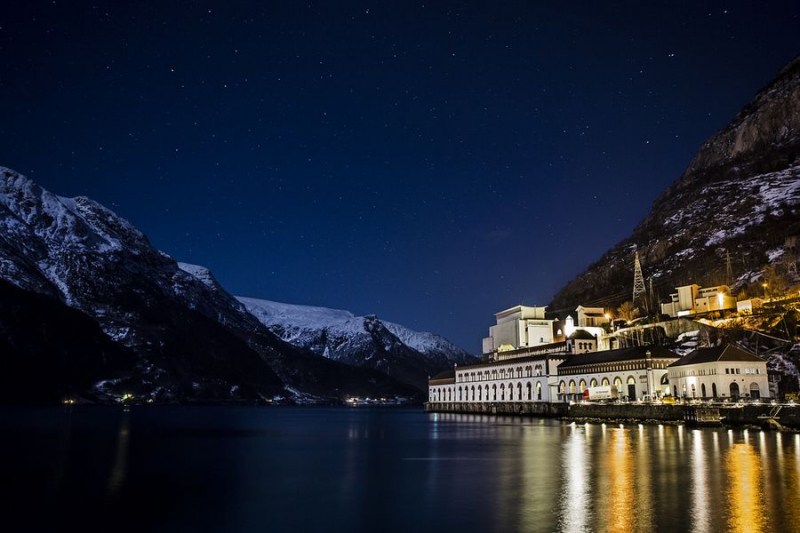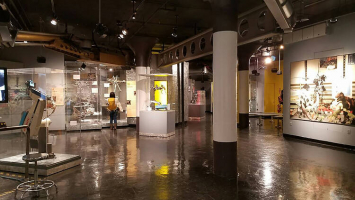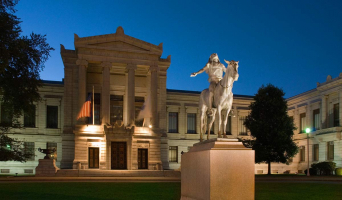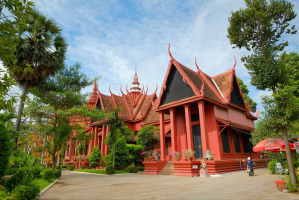Top 5 Best Museums to Visit in Norway
Norway is home to several of Europe's best museums. Norway is packed with museums devoted to various parts of its distinctive past, from a museum dedicated to ... read more...the raucous antics of the Vikings to an institution dedicated to the horrific history of leprosy. Let's have a look at the top museums in Norway.
-
The Holmenkollen Ski Museum (Norwegian: Skimuseet I Holmenkollen) is located in Oslo, Norway, at the base of the Holmenkollen ski jump. The Ski Museum, which was established in 1923, is the world's oldest ski museum. Hjalmar Welhaven, an architect, founded the museum. His personal collection served as the foundation for the museum's antique and vintage skis. The collection was held at a building in the Oslo suburb of Frognerseteren until 1951. The museum collection was relocated to new premises in Holmenkollbakken in 1951 as part of the redevelopment of Holmenkollbakken.
The museum exhibits 4,000 years of skiing history, beginning with Stone Age rock sculptures. It also features Viking-era skiers with skis. It also showcases equipment from both Fridtjof Nansen and Roald Amundsen's arctic missions. Skiforeningen owns and operates the Ski Museum. This organization is in charge of organizing sports, activities, and events in Holmenkollen National Park.
Location: Kongeveien 5, Oslo 0787
Website: skiforeningen.no

Holmenkollen Ski Museum 
Holmenkollen Ski Museum -
Munch Museum (Norwegian: Munch-Museet), from 2020 branded as Munch (stylized as MUNCH), is an art museum in Bjrvika, Oslo, Norway, dedicated to the life and works of Norwegian artist Edvard Munch. The museum was first housed at Tyen, which opened in 1963. The museum relocated to Bjrvika's new museum building, which opened on October 22, 2021.
Most people have heard of Edvard Munch, the Norwegian artist who created The Scream, but they may be unaware that Munch made many versions of this iconic piece, including two paintings and two pastels. The Munch Museum has one of the paintings (the other is at the neighboring National Gallery), as well as a significant collection of the prolific artist's more than 1,200 paintings, 18,000 prints, and six sculptures. Visitors to the museum are also welcome to visit Ekely, his home, and studio located six miles to the west of the museum.
Location: Tøyengata 53, Oslo 0578
Website: munchmuseet.no

Munch Museum 
Munch Museum -
The Norwegian Museum of Hydropower and Industry (Norwegian: Norsk Vasskraft- og Industristadmuseum) is a cultural history museum at Odda in Vestland county, Norway. The museum is located in the village of Tyssedal. The museum is dedicated to the industrial history of Odda and Tyssedal, and more generally to history related to rivers and water, hydropower production, electricity, power-intensive industry, and its society.
The Tysso I power plant, designed by architect Thorvald Astrup (1876–1940) and built between 1906 and 1918, is a major attraction. The station has machinery and control room equipment throughout the station's entire operating history, from 1908 to 1989. The Norwegian Directorate for Cultural Heritage preserved the Tyssedal power plant for posterity in 2000, comprising Tysso I, pipelines, distribution pool and watchman's home at Lilletopp, and intake pool and valve house at Vetlevann. The power plant was extensively restored in the years that followed.
The old administration building for AS Tyssefaldene, the power generating business that owns and manages the hydropower plant, is located near the power station. The museum's displays, library, archives, picture and audio collections, as well as an auditorium, are now housed in the building. It is possible to see the installations at Lilletopp, Vetlevann, and the Ringedals Dam farther upstream. The museum also includes three historic workmen's homes in Odda and a tiny former hydrologic research station at the glacier Folgefonna. A via Ferrata has been constructed to allow safe climbing up the extremely steep pipeline.
Location: Naustbakken 7, Tyssedal, Hordaland 5770
Website: kraftmuseet.no/frontpage/

Norwegian Museum of Hydropower and Industry 
Norwegian Museum of Hydropower and Industry -
The Vigeland Museum (Norwegian: Vigelandmuseet) is a Gustav Vigeland museum in Frogner, Oslo. It is located outside of Frogner Park, which features Gustav Vigeland's sculpture installation. The museum is run by the cultural department of the city of Oslo. Gustav Vigeland (1869–1943), Norway's most famous sculptor, is the subject of the museum. Vigeland's former studio and the apartment are now a museum. His urn and ashes are kept in the museum's tower. He created his own bronze urn and burial marker, which is positioned on the second level above his residence. In 2019, the Vigeland Museum commemorated Gustav Vigeland's 150th birthday.
Lorentz Ree created the structure, which is one of Norway's finest specimens of neoclassical architecture. Its history began in 1919 when sculptor Gustav Vigeland offered to gift his works to the Oslo Municipality at some point in the future. Vigeland's oeuvre included not just sculptures, but also woodcuts, drawings, sketches, and photos, as well as letters, other writings, and a personal library. When a section of the city of Oslo where Gustav Vigeland resided and had his atelier was razed owing to city planning, the artist and the city of Oslo reached an agreement: Vigeland sought an atelier. After his death, the atelier might be reconstructed as a museum.
Location: Nobels gate 32, Oslo 0268
Website: vigeland.museum.no

Vigeland Museum 
Vigeland Museum -
Lillehammer Art Museum (Norwegian: Lillehammer kunstmuseum) is a Norwegian art museum in Lillehammer. The museum was established as a gift from merchant Einar Lunde in 1921. It comprises three primary collections, one of which includes approximately 100 paintings by Matisse school devotees donated by Einar Lunde in the 1920s. Oscar Johannesen, an antique trader, donated his whole 19th-century collection in 1958. Jon Dobloug gave a large portion of his collection, comprising 159 works from the 1980s and 1990s, in 2008.
The oldest section of the collection, photographs donated by Lunde and Johannessen, is mostly located in the 1963 structure created by architect Erling Viksj. The modern structure (Flygelet) was designed by Snhetta and first opened to the public in 1992. This structure served as the major site for cultural programs at the 1994 Winter Olympics.
Location: Stortorget, Lillehammer, Innlandet 2609
Website: en.lillehammer.com/things-to-do/lillehammer-art-museum-p631093

Lillehammer Art Museum 
Lillehammer Art Museum


























